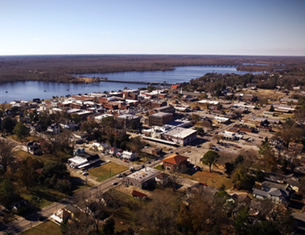Publisher's Note: This post appears here courtesy of the
Carolina Journal. The author of this post is
CJ Staff.
The John Locke Foundation, a free market think tank in Raleigh, has recently wrapped production of its first film: a short titled 'In the Pines.' We sat down with Locke's creative director, Greg de Deugd, who also produced the film.
CJ: You are the producer of
"In the Pines." What does the producer do?
GD: Quite a lot on a small project. On 'In the Pines' I mostly did the creative producer role. I pitched the idea at Atlas Network's
"Lights Camera Liberty" competition. The pitch won and Locke received a grant and production support to help us make the film. Then, I wrote the initial screenplay and brought on some other writers to make sure it was solid. Just Add Firewater, our production partner, helped immensely to make sure it was a shootable script. After that initial creative work, the producer's second job is to assemble the core creative team, casting, hiring all the crew, and making sure the director has everything he needs to make it a great film.
CJ: So why is John Locke Foundation making films?
GD: Well, we decided to expand our video offerings recently because, more and more, video is how audiences are getting their information. It was a natural build up to making films. I think films are the most effective because they're a shared experience. They can help bring people together, spur conversations, and are incredibly effective at introducing people to new ideas which they can then go and investigate, freely, on their own.
CJ: What is the story of this film,
"In the Pines"?
GD: It is a short historical drama: a tragedy about three kids, young adults, who get caught up in racial and political violence in turn-of-the-century North Carolina. It's really about the possibility of love and friendship in violent times, the damage of political factions, political violence. In the face of evil and hate, can love win in the end?
CJ: Can it?
GD: It has to. But there is a lot of brutality in the world, and we have to acknowledge that violence and hate are real and cause lasting damage. There are evil forces out there, and we must fight back against them. Constantly.
CJ: You said turn-of-the-century North Carolina racial violence. Is this related to the 1898 Wilmington massacre?
GD: Yes. That violent era is the backdrop to this film. In 1898, in North Carolina, the Democratic Party and the News and Observer orchestrated what they called their "Campaign of White Supremacy."
CJ: And can you explain the history there?
GD: So the Democrats controlled North Carolina for a generation after the Civil War. They briefly lost power in 1894 to an alliance of Republicans, black North Carolinians, and populists. But they were determined to regain power in the election of 1898. They didn't waste time. They created a massive statewide propaganda effort meant to divide the white and black coalition in North Carolina in order to win that election. They printed disgusting racist cartoons. They wrote fake news stories framing black people for crimes they didn't commit. There was violence, voter intimidation, voter suppression. They even had their own sort of paramilitary group called the redshirts.
CJ: And it worked?
GD: Yes, the lies and the violence worked. It was terrible. Hundreds, maybe more, were killed in the violence. Democrats won the 1898 election, went right back to institutionalizing Jim Crow laws, and then stayed in power for 100 years. I think until 2010.
CJ: There was even an actual coup in there, correct?
GD: That's right. The only coup d'etat to ever occur on American soil. An armed force marched on Wilmington, removed the Republican aldermen, and installed a Democrat board.
CJ: So political violence and racism are themes of the film?
GD: Yes. Also the relationship of the past to the present. We deal with politics, but it is mainly a simple story of good and evil, these young people having their world ripped out from under them. What would it have been like for kids who grew up in Wilmington in that time? A racially diverse, relatively harmonious, and prosperous community which is what Wilmington was at that time. They suddenly have their friends become their enemies, have their lives torn apart, and their world literally burned to the ground? All just for someone's political gain?
CJ: That sounds like a lot to pack into a short film.
GD: It's ambitious. But the short is just a vignette. And it's one out of hundreds of stories we could tell from this era. We originally wrote this as a feature-length film, so we picked just this one little piece to use as a proof of concept, so we could do it well. The real story is way bigger, and we hope to expand upon it later.
CJ: But tell us about the production. Did you have any problems getting people to work on the film, given its content?
GD: No, not at all. We wrote a good story. It has relevance to our lives today. I think most people would agree that the events that serve as the backdrop to the story are horrible, but they are a historical reality, and we need to reckon with it if we want to try to create a better world. We don't make progress by ignoring the past. And lying about the past is very dangerous. Maybe even more dangerous is telling half-truths about the past. We need to get it all out.
CJ: How did you cast the film?
GD: Raphael Siary did our casting. He's a trained actor himself and had amazing success lining up talent. We had over 1,200 actors apply, and we auditioned maybe 60-80 people. And we really got the cream of the crop, an extraordinary ensemble.
CJ: It's a period piece, so was that difficult to do on a small budget?
GD: Yes, definitely. But we were able to secure some tremendous historic locations, partly because they believed in the project. We shot the film in Wilmington because of the availability of period-appropriate locations, plus there are many talented crew and vendors already there. The film commission, the city, and the county were all very helpful. It is an A+ filmmaking town. We were fortunate enough to be able to hire amazing wardrobe people, makeup artists, and hair stylists. The only way to pull off a period piece is to have those professionals in place.
CJ: And who directed this?
GD: Our director is Dugan Bridges, an immensely talented filmmaker based in Georgia. He has done work for Dreamworks, Lionsgate, and Robert Zemeckis. He is just really good with actors as well as the technical aspects of filmmaking... a true film artist and craftsman.
CJ: What is next for the film and for the John Locke Foundation?
GD: Next we are doing post-production, the editing and music, and we'll be raising some money to finish the film. So if any of your readers want to become executive producers or get their names in the credits, we are offering that to donors. They can just contact the John Locke Foundation and say they want to be involved.
CJ: Well, the film looks great.
GD: Thanks. What we got in the can is amazing work. We will use the film to help bring attention to Locke's North Carolina History Project. But good work just builds value and leads to more opportunities. We may use this to raise money for a feature-length film, a series, or even produce more historical fiction related to North Carolina history.
CJ: Thanks for the chat!
GD: Thank you!






















